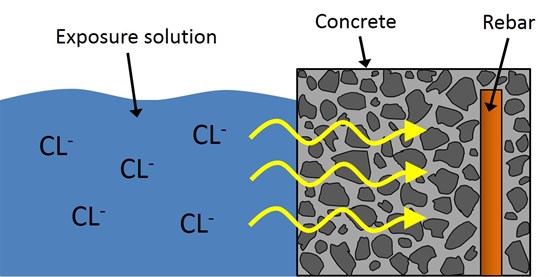Chloride binding in concrete
It is well-known that
when chloride ions ingress
into concrete (Fig. 1) part of the penetrating ions becomes
fixed to the cement paste hydrates. This phenomenon is commonly
referred to as chloridebinding and is important in connection
with chloride-induced
reinforcement corrosion, since the binding of chlorides reduces the amount of
free chlorides available
in the pore solution for initiation of reinforcement
corrosion.

Fig. 1: Schematic illustration
of the ingress of chloride ions from an exposure
solution (e.g. seawater) into a reinforced concrete
structure.
New modelling tool for
prediction of chloride binding
A modeling tool for quantification
of chloride binding and for prediction of pore
solution chemistry in concrete has been developed at the
Infrastructure Expert Centre, which allows a ranking of different
cement-based binders in terms of the ability to ensure a low
[Cl-]/[OH-] ratio in the pore solution, a
parameter generally known to be very important for the initiation
of reinforcement corrosion in concrete.
The prediction tool is based on an
existing model, which was originally developed in a PhD project at
the Technical University of Denmark. However, the work carried out
at DTI has resulted in a significant expansion of the model, which
can now be applied to a much wider range of binder compositions,
e.g. binders with a high content of fly ash and/or microsilica.
The developed modeling tool has
been validated by a series of laboratory experiments, which
demonstrated the capability of the model to quantify thebinding of chloride in concrete. Furthermore, the
inherent ability of the tool to predict the phase assemblage in
hydrated cementitious systems has been confirmed by comparison with
data from microscopic investigations of concrete samples collected
from a series of old Danish coast bridges (i.e. samples collected
from concrete structures after long-term exposure to seawater). A
short description (in Danish) of the modelling tool can be found
below:
New tool for calculation of chloride binding in
concrete (in Danish)